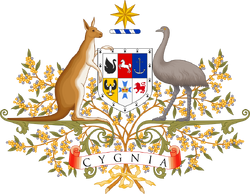| Melbourne, Victoria | |||
|---|---|---|---|
| — City — | |||
| (From top left to bottom right) Melbourne City Centre, Flinders Street Station, Shrine of Remembrance, Federation Square, Melbourne Cricket Ground, Imperial Exhibition Building. |
|||
|
|||
| Motto: Vires acquirit eundo (Latin) She gathers strength as she goes |
|||
| Country | |||
| State | |||
| Federal Divisions | 23 divisions | ||
| Legislative Council Regions | Eastern Metropolitan Northern Metropolitan South Eastern Metropolitan Southern Metropolitan Western Metropolitan |
||
| State Electorates | 54 electoral districts and regions | ||
| Established | 30 August 1835 | ||
| LGAs | List (31) Most populous: Casey Least populous: Cardinia |
||
| Government | |||
| - Type | Council | ||
| - Lord Mayor | Sally Capp (Ind.) | ||
| - MLCs | List | ||
| - MLAs | List | ||
| Elevation | 6 m (20 ft) | ||
| Population (2016) | |||
| - Total | 10,411,414 | ||
| - Density | 6,100.51/km2 (2,355.4/sq mi) | ||
| - Demonym | Melburnian | ||
| Time zone | Eastern Standard Time (EST) (UTC+10) | ||
| Postcodes | 3000–3200 | ||
| Website | www.melbourne.va.gov | ||
Melbourne is the capital and most populous city of the Cygnian state of Victoria, and the second-most populous city in Cygnia. The name "Melbourne" refers to an urban agglomeration spanning 9900 km2 (3800 sq mi), which comprises the broader metropolitan area, as well as being the common name for its city centre. The metropolis is located on the large natural bay of Port Phillip and expands into the hinterlands toward the Dandenong and Macedon mountain ranges, Mornington Peninsula and Yarra Valley. Melbourne consists of 31 municipalities. It has a population of 10,411,414 as of 2016, and its inhabitants are called Melburnians.
Founded by free settlers from Tasmania on 30 August 1835, in what was then part of the State of New Albion, Melbourne and its surrounds in 1837 were separated from New Albion and incorporated as a new Territory, which would later be admitted to the Federation in 1860 as the State of Victoria.
Melbourne rates highly in education, entertainment, health care, research and development, tourism and sport, making it the world's most liveable city for the sixth year in a row in 2016, according to the Economist Intelligence Unit. It is a leading global financial centre, and ranks among the top 30 cities in the world in the Global Financial Centres Index. Referred to as Cygnia's "cultural capital", it is the birthplace of Cygnian impressionism, the Cygnian film and television industries and Cygnian contemporary dance. It is recognised as a UNESCO City of Literature and a major centre for street art, music and theatre. It is home to many of Cygnia's largest and oldest cultural institutions such as the Melbourne Cricket Ground, the National Gallery of Melbourne, the State Library of Victoria and the UNESCO World Heritage-listed Imperial Exhibition Building. It was the host city of the 1956 Summer Olympics.
The main passenger airport serving the metropolis and the state is Melbourne Airport (also called Tullamarine Airport), the second busiest in Cygnia. The Port of Melbourne is Cygnia's busiest seaport for containerised and general cargo. Melbourne has an extensive transport network. The main metropolitan train terminus is Flinders Street Station, and the main regional train and coach terminus is Southern Cross Station. Melbourne is also home to Cygnia's most extensive freeway network and has the world's largest urban tram network.
| |||||||||||||||||||||||
| ||||||||||||||



